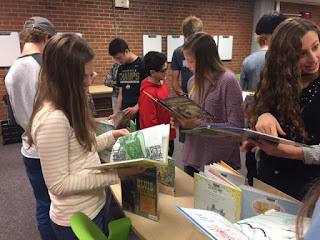 |
| Dena Little, Children's Librarian from the Upper Arlington Public Library |
"Next week, before we discuss our new business updates, or any policy changes, all of you are going to stand up in front of your co-workers and assume four different character voices--gestures and all--and recite your favorite children's book."
I can imagine a snapshot of the crowd: eyes wide, brows raised, fingers massaging a sea of temples.
You've got to be kidding me, many of your coworkers say without words, although a few manage to open their mouths and argue about the absurdity. Your boss, however, remains vigilant, "It's good for you," he or she says and then leaves the room.
Despite the fact every last person has crossed the threshold from adolescence to adulthood--and stereotypes tell us that means they have, in theory, left their awkward years and insecurities behind--the crowd throbs with anxiety.
I'm going to look ridiculous...
What if I forget what I'm supposed to say...
People are going to laugh at me...
It doesn't matter how old we are, fear and insecurity are powerful entities in our lives, and we must all learn to face them both, to embrace them, to manage them, so we can find a way to triumph, to overcome.
And when we do, authenticity, connection, and growth often emerge.
In an effort to equip her students with what it takes to overcome fear and insecurity, Amanda Fountain has assumed the role of boss, and she's issued the aforementioned assignment. Hoping to help her classes realize the we way we beat the monsters in our lives--the way we control them--is to hold the reigns, to embrace our vulnerability, to wrestle with being uncomfortable so we can learn to manage the discomfort.
By the start of second quarter, she said her public speaking students have had the chance to develop skills through an introductory speech, a demonstration speech, a "review" speech and an informative speech, but Fountain has noticed that many kids still struggle with ease, with letting go and allowing their personality to leak out on stage. They're often stiff, overly concerned with how their peers perceive them, and have a resistance to use gestures to enhance the messages they're delivering. For that reason, Fountain assigns the vocal variety speech at the start of second quarter. In this assignment, students have to assume at least four different voices as they interpret a children's book for the class.
Over the years, after assigning this speech, Fountain has noticed students were often held back by the first choice they made: which book they wanted to use. To make life easier, many would pick a board book from home without worrying about whether or not it was fitting for the assignment, and others would "forget" their book altogether, losing valuable prep time in an effort to prolong the inevitable.
This past June, while teaching the 4-hour blocked summer school class, Fountain thought of a solution. When it came time for the vocal variety speech, she advised students to bring their library cards and then she walked them over to Northam Park, up to the main library and into the children's book section. There, high schoolers stood beside children as both groups poured over the stories, and Fountain stepped back as it happened, watching kids engage as they never had before. Later, when students stood up to present, she noticed the performances had much more texture.
Eager to carry the energy over to the school year, Fountain reached out to Tracie Steele, the librarian she worked with over the summer. Strapped by our 48 minute class periods and the implausibility of walking students over to the main library during that time, Fountain searched for a way to bring the books to her students. Tracie connected her with Dena Little, one of her colleagues, and Dena arrived eagerly, with a table full of stories, a device to check them out, and a plethora of advice.
She talked to students about getting into character, about the importance of making yourself comfortable, of letting loose and being silly, of recognizing that everyone was going to be in the same boat, feeling the same discomfort.
But she not only told them, she made herself vulnerable. Instead of choosing stories that catered to her strengths, she exposed an area she admitted was a weak.
"My Irish accent isn't great," she told them, after using it for one of the characters, "but I'm trying it and that's all that matters."
She talked to them next about helping the audience.
"When the speaker is uncomfortable," she said, "it's awkward. The more crazy and outgoing you are, the more your audience will get into it."
She went on to show them how to use their bodies to reflect the character's own body language and she advised them to break the fourth wall, to address the audience directly if it seemed appropriate, if they needed to give context or wanted to ask listeners to connect to the events in the story.
When she finished, students rose from their seats and crowded around the table of books, flipping through pages, making their way through stories. And the entire time I watched, not a single one widened his or her eyes, raised his or her brows or rubbed his or her temples.
Instead, they were laughing, reminiscing, searching for the perfect set of characters, the perfect entry-point for their performance.
They were digging right in.
Facing challenges head on.
Accepting the call to adventure--just like the characters in their story--crossing the threshold and beginning a journey that will make them just a little bit more brave, a journey that will allow them to crack open their fear, and let their personality leak out onto the stage.

No comments:
Post a Comment